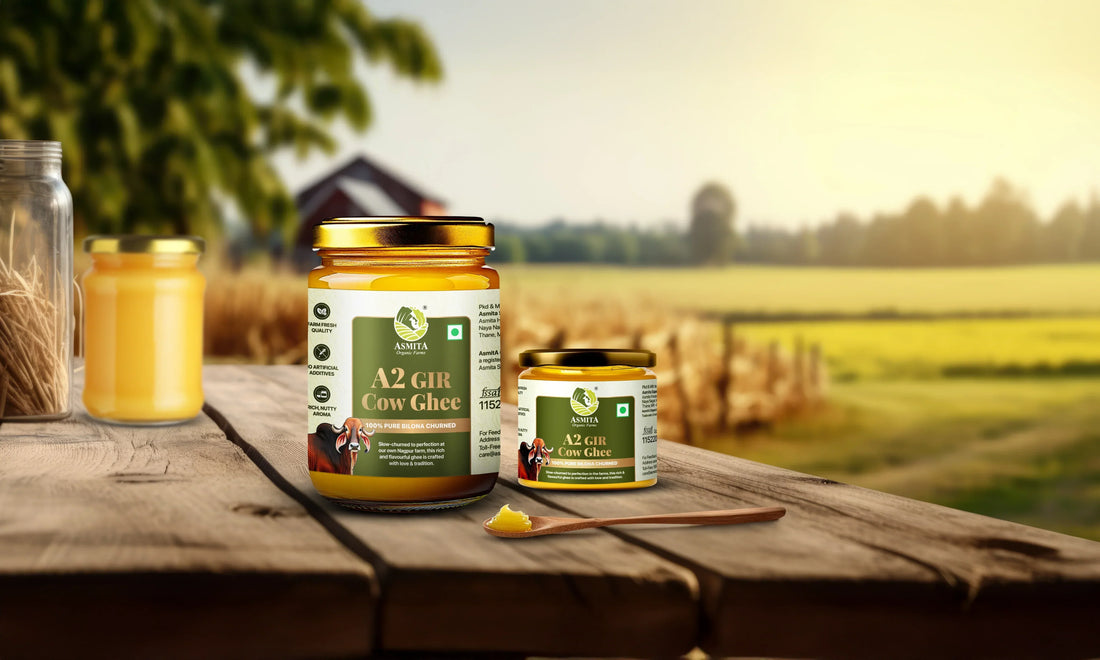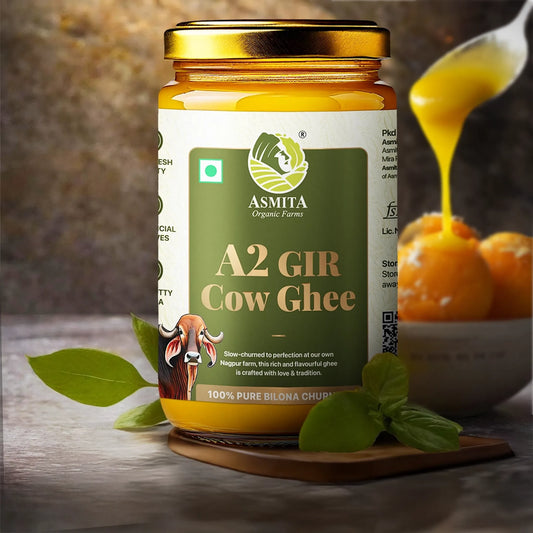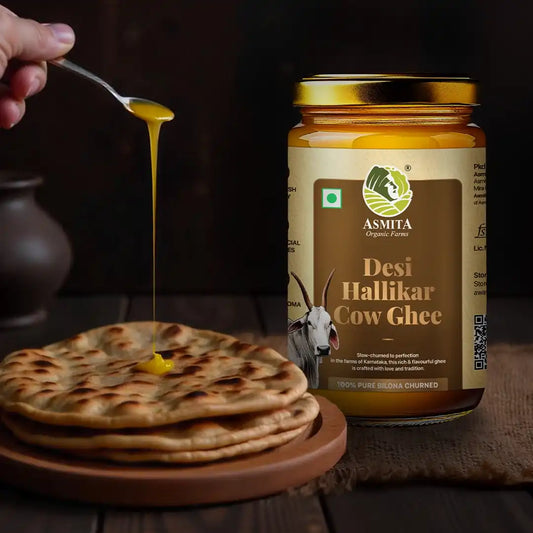A2 vs Regular Ghee – Which is Healthier?
5 min read
In the world of wellness and traditional cooking, ghee has always been gold. Quite literally. It’s the heart of Indian kitchens, passed down in ladles and stories — the kind your grandmother swore by, the kind that crackles in the pan and instantly makes dal taste like home.
But now, there’s a new question on the table: A2 vs regular ghee — what’s the better choice? To get to the truth, we’ll need to zoom out a bit—look at the kind of milk they’re made from, the cows behind them, and the science that’s fuelling the buzz.
Let’s break it down, myth-bust a little, and help you choose the ghee that actually suits your body and lifestyle.
Table of Contents
1. What is A2 Ghee?
2. What is Regular Ghee?
3. Health Benefits of A2 Ghee
4. Is Regular Ghee Bad for You?
5. Which Ghee Should You Choose?
6. Bottom Line
What is A2 Ghee?
A2 ghee is prepared using the milk of native Indian cows such as Gir, Sahiwal, or Red Sindhi. These cows naturally produce milk in which only the A2 beta-casein protein is present, which is easier to digest and less inflammatory as compared to its A1 version.
Moreover, it is made by using the conventional Bilona method, churning curd (not malai) in small batches, and then slowly boiling to get ghee. This preserves more nutrients, and this process is high in antioxidants, vitamins, and essential fatty acids.
What is Regular Ghee?
Now, what about the ghee many of us grew up with? Regular ghee is commonly made from the milk of high-yield foreign-breed cows like Holstein or Jersey.
These cows produce A1 milk, which contains a mix of A1 and A2 beta-casein proteins. This might seem like a minor difference, but studies suggest that A1 beta-casein can be harder to digest and may trigger discomfort in individuals with lactose intolerance or casein sensitivity.
Additionally, most commercially produced regular ghee is made using a cream-based process rather than the curd-churning method. This quicker process may compromise the nutritional profile of the final product.
So, in the debate of desi cow ghee vs dairy ghee, the method and the source of milk both play key roles.
Health Benefits of A2 Ghee
When it comes to nutrition, A2 ghee takes the lead with multiple health benefits. Let’s explore the benefits of A2 ghee that make it special:
1. Digestive Health
A2 ghee is known to stimulate digestive enzymes and soothe the gut lining. Because it lacks A1 protein, it's gentler on the stomach and less likely to cause bloating or discomfort.
2. Rich in Vitamins and Healthy Fats
A2 ghee is packed with fat-soluble vitamins like A, D, E, and K, essential for maintaining good eyesight, strong bones, and healthy skin. It also contains Conjugated Linoleic Acid (CLA), which is believed to have anti-cancer and anti-inflammatory properties.
3. Supports Immunity
The traditional Bilona-prepared A2 ghee retains beneficial short-chain fatty acids (SCFAs) like butyrate, which support the immune system and maintain colon health, making it an excellent remedy for constipation and overall digestive wellness.
4. Mental and Heart Wellness
The Omega-3 fatty acids in A2 ghee improve cognitive function and reduce the risk of heart disease. It also promotes a healthy cholesterol balance when consumed in moderation.
Is Regular Ghee Bad for You?
Not exactly. Regular ghee still offers some nutritional value, such as providing energy and fat-soluble vitamins. However, it does come with certain concerns:
- Contains both A1 and A2 beta-casein proteins, which may be problematic for people sensitive to dairy.
- Mass production often involves high heat processing, which can degrade nutrients.
- Often made from milk sourced from factory-farmed cattle exposed to antibiotics and hormones.
- Not all brands use the traditional method, which affects both taste and quality.
So while regular ghee isn’t "bad," it might not provide the same holistic wellness benefits as A2 ghee. For those who are lactose intolerant or have digestive issues, A2 ghee is usually a better and safer choice.
Which Ghee Should You Choose?
Choosing between A2 vs regular ghee boils down to your health goals, dietary preferences, and values. Here’s a quick comparison to help you decide:
|
Feature |
A2 Ghee |
Regular Ghee |
|
Source |
Indigenous desi cows (A2 milk) |
Crossbred/Holstein cows (A1 milk) |
|
Digestion |
Easy to Digest |
May cause issues in sensitive individuals |
|
Beta-Casein Protein |
Only A2 |
A1+ A2 |
|
Production Method |
Traditional (Bilona) |
Industrial/Cream-based |
|
Nutritional Value |
Higher (Loaded with vitamins A, D, E, and K) |
Moderate |
|
Taste and Aroma |
Rich and Nutty |
Mild |
If you’re someone who values clean, natural nutrition and supports traditional farming, desi cow ghee vs dairy ghee becomes an easy choice.
On another note, to truly understand the A1 vs A2 ghee debate, let’s zoom in on the beta-casein protein. Milk contains several types of protein, and casein makes up about 80%.
Within that, beta-casein exists in two primary variants: A1 and A2. The difference between A1 and A2 milk lies in a single amino acid.
But this small change affects how the body digests the protein. During digestion, A1 beta-casein can produce a peptide called BCM-7, which is linked to inflammation, heart issues, and digestive discomfort.
A2 milk, on the other hand, does not produce BCM-7, making it easier to digest and better suited for those with dairy sensitivities. As a result, A2 ghee made from A2 milk inherits these health benefits.
Bottom Line
In the battle of A2 vs regular ghee, A2 ghee wins not just on paper but in overall well-being. It honours tradition, supports digestion, boosts immunity, and delivers a rich nutritional profile that regular ghee often lacks.
If you’re looking for pure, traditionally made A2 ghee, AsmitA Organic Farms’ A2 Gir Cow Ghee and Hallikar Cow Ghee are crafted from the pure A2 milk of native free-grazing grass-fed Gir and Hallikar cows raised on our lush farms in Nagpur and Karnataka, respectively.
Prepared using the traditional Bilona method, this ghee is rich in A2 protein, CLAs, and short-chain fatty acids, offering powerful benefits for digestion, immunity, and heart health. Its nutty aroma and high smoke point (up to 252°C) make it perfect for everyday cooking.
Explore the range of A2 ghee products at AsmitA Organic Farms and bring home the gift of purity today.












